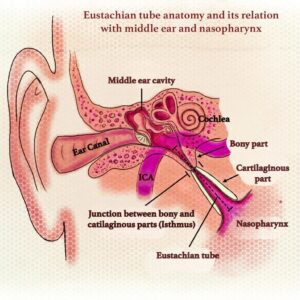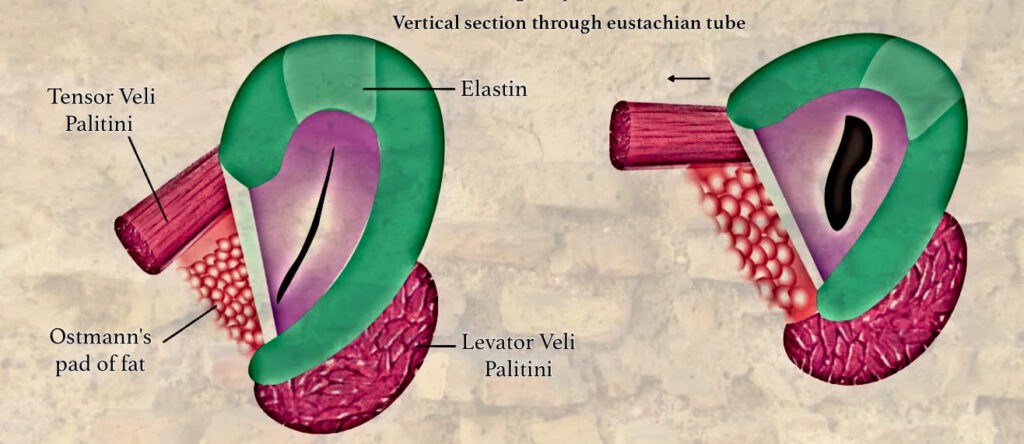EUSTACHIAN TUBE ANATOMY: Eustachian tube is named after Bartolomeo Eustachius (1520-74 AD). Eustachian tube (pharyngotympanic tube) is a dynamic, mucosa lined channel which connects the middle ear cavity to the nasopharynx. It extends from the anterior wall of the middle ear to the lateral wall of the nasopharynx. Eustachian tube runs downwards at an angle of 45°, from the tympanic end of middle ear cavity and passes forwards and medially to reach nasopharynx.
In a normal adult, the length of the tube is about 36 mm which is normally reached until the age of 7 years. While in infants and young children, the tube is shorter, wider, more horizontal and less efficient. Hence eustachian tube dysfunction is commonly seen in infants and young children.
The tube has two parts (bony and cartilaginous), and it is reverse of what is present in the external auditory canal:

- Bony part, which is upper, posterolateral one-third (12 mm) and begins from the anterior wall of the tympanic cavity. The bony tympanic end is oval-shaped opening, measures 5 × 2 mm and it is located in the anterior wall of the middle ear, a little above the level of the floor. It is lined with a thin layer of cuboidal respiratory epithelium.
- Fibrocartilaginous part, which is lower, anteromedial two-third (24 mm) and opens at the lateral wall of the nasopharynx. It is lined by respiratory epithelium same as epithelium present in the nasopharynx. The cartilage at the pharyngeal end raises an inverted ‘J’ shaped elevation called torus tubarius which is located 1–1.25cm behind and a little below the posterior end of the inferior turbinate. Above and behind the torus tubarius is a recess called fossa of Rosenmuller, which is the common site for nasopharyngeal malignancy. During childhood, tubal tonsils are present around the tubal elevation, hypertrophy of which cause eustachian tube obstruction. The fibrocartilaginous part of the tube is made of a single piece of cartilage folded upon itself in such a way that it forms the whole of the medial lamina, roof and a part of the lateral lamina; the rest of its lateral lamina is made of the fibrous membrane.
Elastin hinge: It is rich in elastin fibres and is situated in the roof at the junction of the medial and lateral lamina. By its recoil it keeps the tube closed when dilator of ET (tensor veli palatini) is not in action. Both parts meet at isthmus which is the narrowest part (diameter is 0.5mm or less) of the tube.

Muscles attached to eustachian tube. The muscles of the eustachian tube system help open and close the tube. These muscles are Tensor veli palatini (primary dilator), tensor tympani, Levator veli palatini, Salpingopharyngeus. Former two are innervated by the mandibular nerve of the trigeminal nerve, while levator veli palatini and salpingopharyngeus are innervated by the vagus nerve. Tympanic branch of cranial nerve (CN) IX supplies sensory as well as parasympathetic secretomotor fibres to the tubal mucosa.
Ostmann’s pad of fat. It is a mass of fatty tissues located in the inferolateral aspect of the eustachian tube most likely aids in closing the tube. Therefore protect the middle ear from the retrograde flow of nasopharyngeal secretions. Ostmann’s fat pad decreases in volume with an increase in age leading to patulous eustachian tube.
DIFFERENCES BETWEEN THE INFANT AND ADULT EUSTACHIAN TUBE
In infants, the size of ET is about half as compared to the size normally seen in an adult; it averages about 18 mm and reaches adult size by 7 years of age. In infants direction of the tube is also different, it is 10 degrees to the horizontal as compared to 45 degrees in adults. As the eustachian tube of infants is wider, shorter and more horizontal; all the protective function of ET system are less efficient. Even the milk goes into the middle ear if the infants are not fed in a head-up position. Nasopharyngeal secretions can enter more readily into the middle ear and result in middle-ear infection.
| Infant | Adult | |
| Length | 13–18 mm at birth (about half as long as in adult) | 36 mm (31–38 mm) |
| Direction | More horizontal. Forms an angle of 10° with the horizontal. | Forms an angle of 45° with the horizontal |
| Angulation at isthmus | No angulation | Angulation present |
| Bony versus cartilaginous part | Bony part is slightly longer than one-third of the total length of the tube and is relatively wider | Bony part one-third; cartilaginous part two-thirds |
| Tubal cartilage | Flaccid. Retrograde reflux of nasopharyngeal secretions can occur | Comparatively rigid. Remains closed and protects the middle ear from the reflux |
| Density of elastin at the hinge | Less dense; tube does not efficiently close by recoil | Density of elastin more and helps to keep the tube closed by recoil of cartilage |
| Ostmann’s pad of fat | Less in volume | Large and helps to keep the tube closed |
———— End of the chapter ————
Learning resources.
- Scott-Brown, Textbook of Otorhinolaryngology Head and Neck Surgery.
- Glasscock-Shambaugh, Textbook of Surgery of the Ear.
- Logan Turner, Textbook of Diseases of The Nose, Throat and Ear Head And Neck Surgery.
- Rob and smith, Textbook of Operative surgery.
- P L Dhingra, Textbook of Diseases of Ear, Nose and Throat.
- Hazarika P, Textbook of Ear Nose Throat And Head Neck Surgery Clinical Practical.
- Mohan Bansal, Textbook of Diseases of Ear, Nose and Throat Head and Neck surgery.
- Anirban Biswas, Textbook of Clinical Audio-vestibulometry.
- W. Arnold, U. Ganzer, Textbook of Otorhinolaryngology, Head and Neck Surgery.
- Salah Mansour, Textbook of Comprehensive and Clinical Anatomy of the Middle Ear.
- Susan Standring, Gray’s Anatomy.
- Ganong’s Review of Medical Physiology.
Author:

Dr. Rahul Kumar Bagla
MS & Fellow Rhinoplasty & Facial Plastic Surgery.
Associate Professor & Head
GIMS, Greater Noida, India
msrahulbagla@gmail.com
Please read. Glomus Tumour. https://www.entlecture.com/glomus-tumour/
Follow our Facebook page: https://www.facebook.com/Dr.Rahul.Bagla.UCMS
Join our Facebook group: https://www.facebook.com/groups/628414274439500
